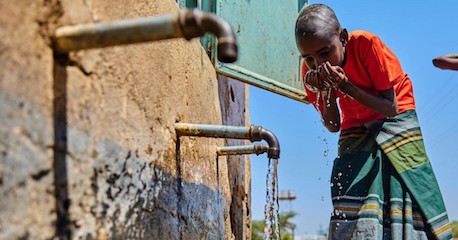Three or four times a day, when mother of two Nasri Garane needs water for her household in drought-stricken Garissa County, eastern Kenya, she drags an empty 20-liter jerrycan to a communal borehole, waits in line to fill the can, then drags it back home over dry, sandy ground.
Garissa County is caught in the grip of a prolonged drought that’s leaving families increasingly desperate. Many have been forced out of their villages in search of water for themselves and their livestock. Cases of diarrhea — a leading killer of children under the age of 5 — are on the rise as families turn to untreated, contaminated river water.
Prolonged drought across the Horn of Africa is threatening children’s lives
Working in collaboration with the county government, UNICEF teams are rehabilitating boreholes to ensure families like Garane’s have reliable, affordable access to the safe water they need to survive.
“I used to walk two hours every day to fetch water from the river when the borehole was not working,” says Garane. “My children would get sick from diarrhea after drinking the dirty river water. But now it only takes me 15 minutes, and no one gets sick anymore because the water from the kiosk is clean and safe. I use it for washing, cooking and even drinking.”
See how UNICEF water programs are keeping children healthy in Kenya:
Above, Garane carries her 2-year-old son, Liban Ali, as she heads to the UNICEF-suported water kiosk near her home in Daley Village, Garissa County. After filling her can, she washes her son’s face to help him cool off.
More than 1,000 families are benefitting from the renovated borehole in Daley, and that number is rising steadily as the drought worsens and members of other communities travel long distances to fetch water here.
UNICEF also distributes water treatment chemicals and hygiene supplies to families in need. “The drought has hit my family hard,” says Habiba Rage, a mother of five, above. “We can only access water from the river through water trucking. My children are often sick from diarrhea and other stomach complications. The household water treatment chemicals are helping us to get clean water for cooking and drinking.”
Rage’s family is one of 2,250 drought-affected households that UNICEF is supporting with water, sanitation and hygiene (WASH) supplies. “We were given a bucket, a jerry can, a bar of soap and water treatment chemicals.” she says. “It has really helped us because we could not buy any of these things on our own. We use the bucket and soap for washing, and the water treatment chemicals for purifying the river water before drinking it.”
For families in Garissa, periods without access to safe water are a familiar hardship, but they have become more frequent in recent years. Unless climate change is addressed, the situation of the people here will only grow worse.
Kenya and other countries in the Horn of Africa are facing the worst drought in 40 years. Support UNICEF’s urgent work for vulnerable children and families across the region. Your contribution can make a difference. Please donate today.
Reporting by Dennis Githieya
Top photo: A child drinks water piped from a borehole rehablitated by UNICEF in Garissa County, Kenya. Photos © UNICEF Kenya/2022/Lameck Orina. Video edited by Tong Su for UNICEF USA.
